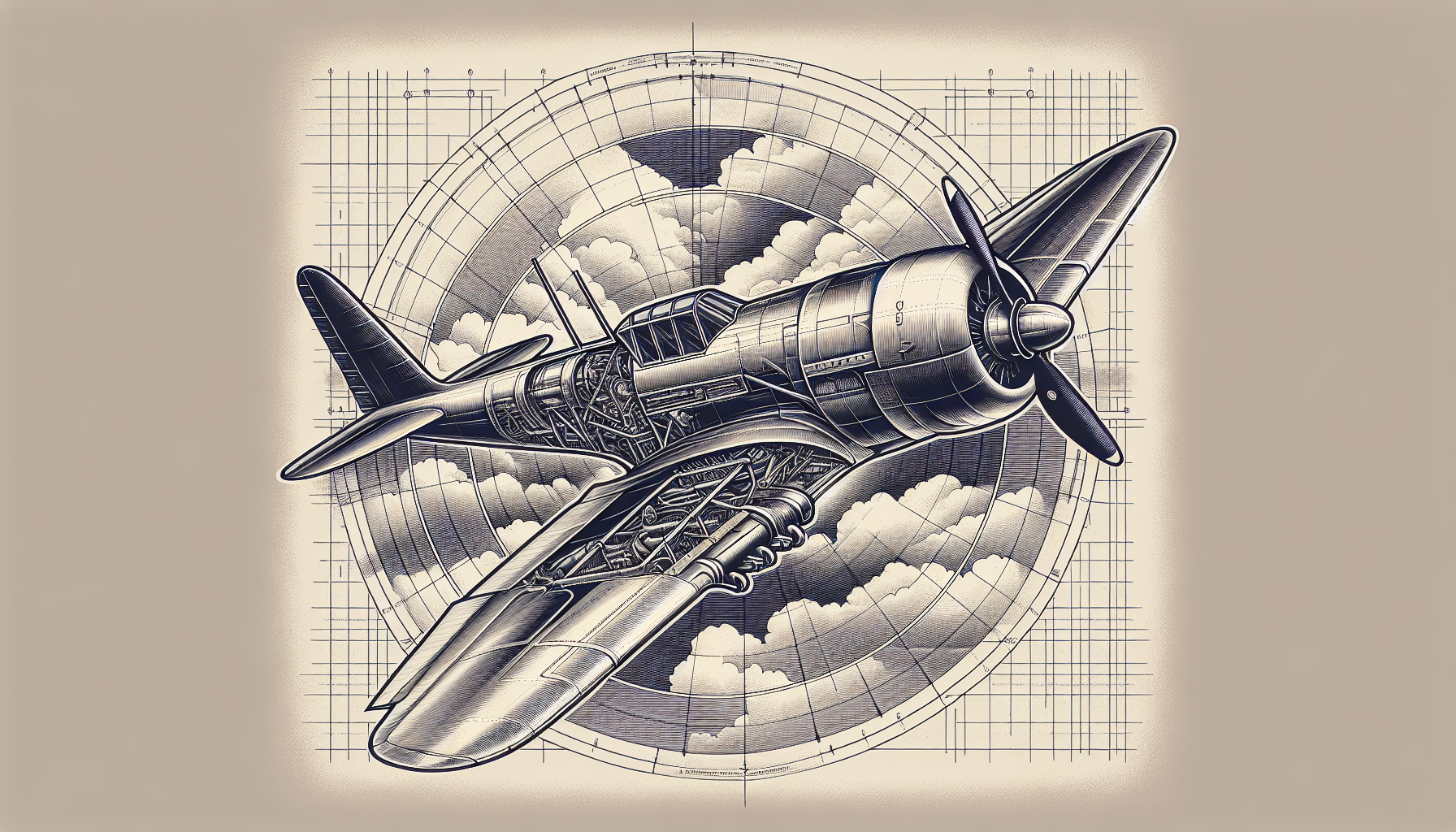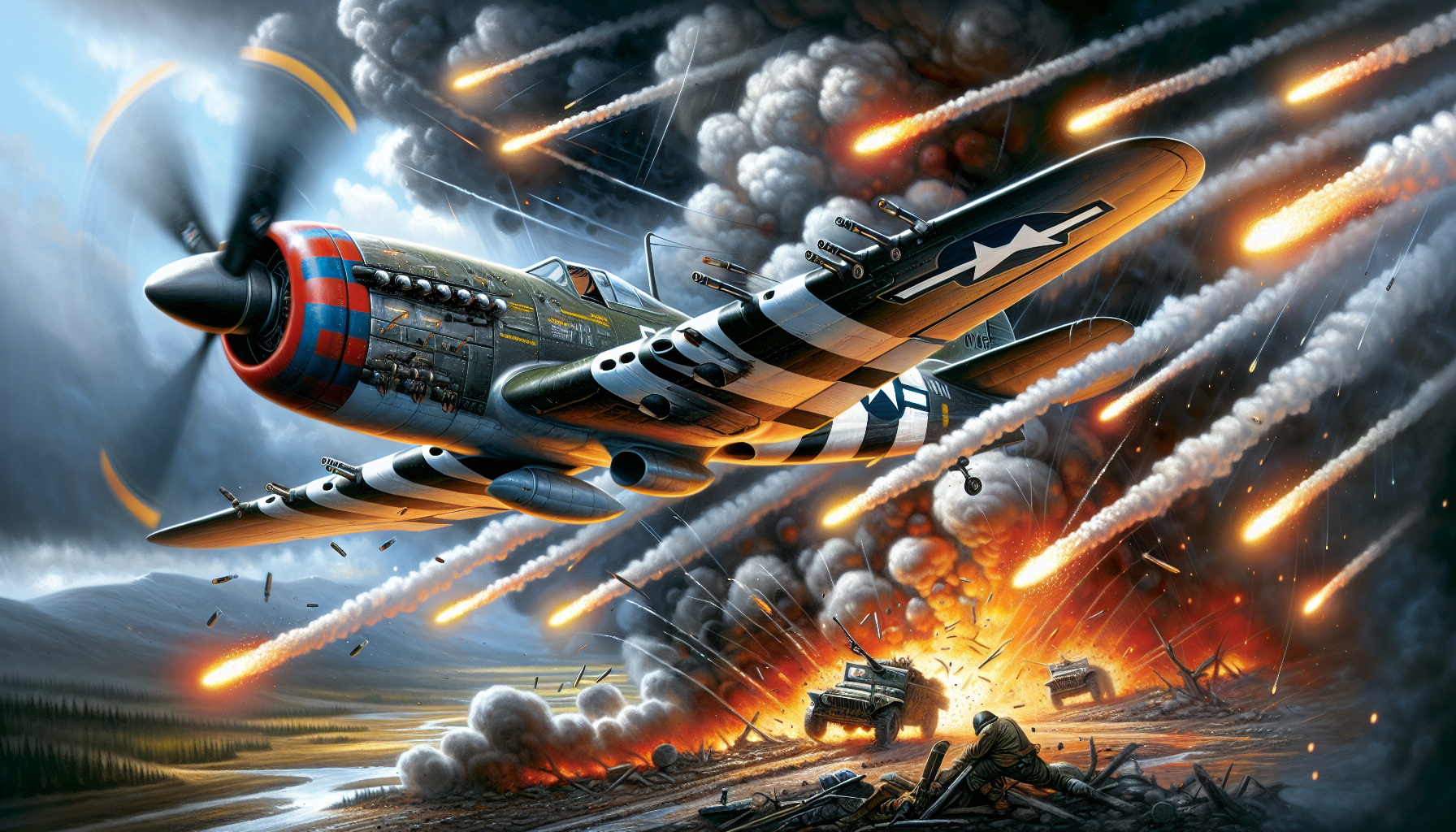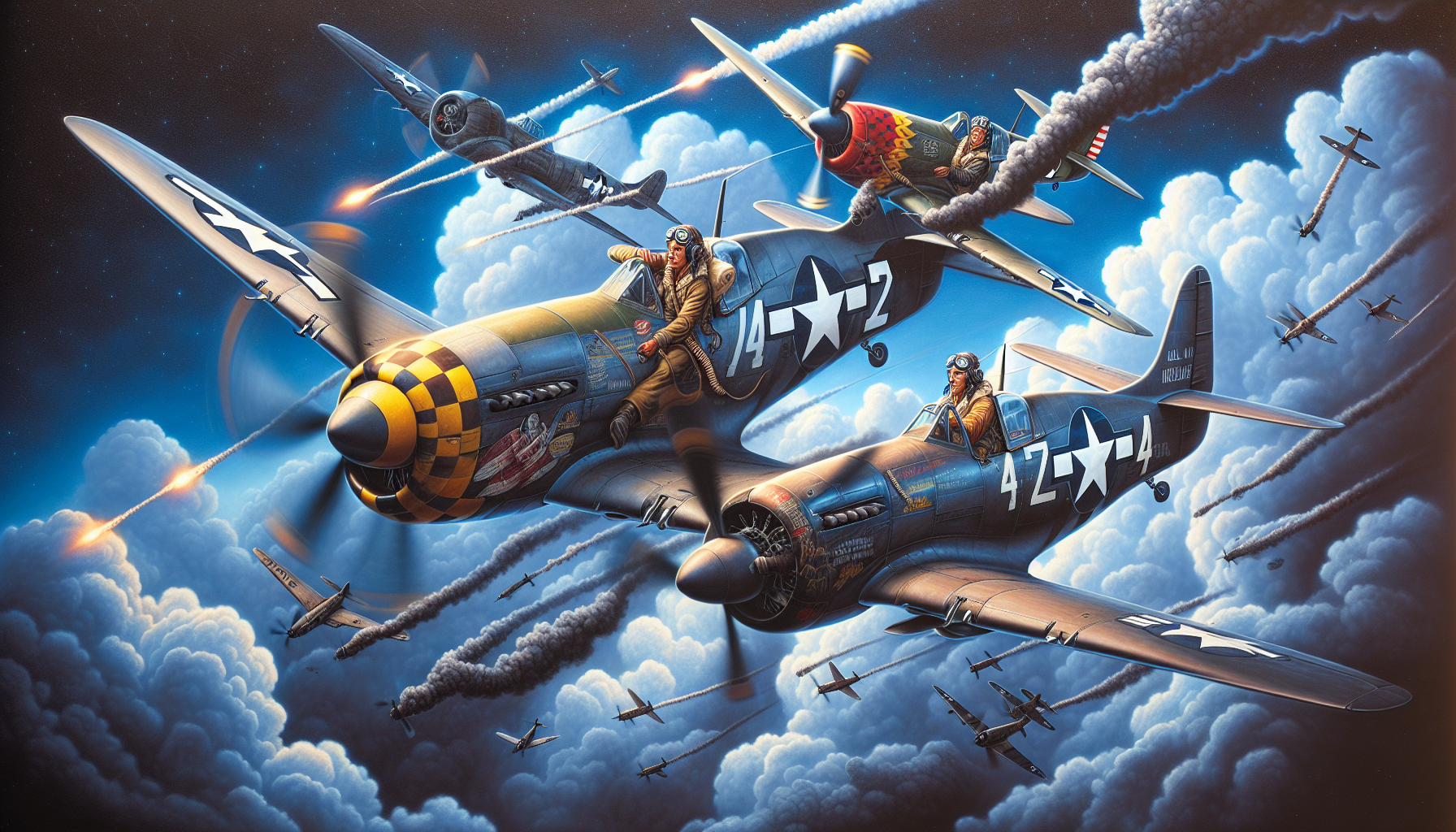P-47 Fighter Plane: Marvel of WWII Engineering
The P-47 fighter plane, pivotal in WWII, was celebrated for its toughness and firepower. This article covers its development, design, and combat achievements.
Key Takeaways
-
The P-47 Thunderbolt originated from early designs by Alexander P. de Seversky and was further developed under Alexander Kartveli, evolving from the Republic YP-43 into one of the most powerful single-engine fighters of WWII.
-
Powered by the Pratt & Whitney R-2800 Double Wasp engine, the P-47 featured high-altitude performance, robust design, and heavy armament, including eight .50 caliber machine guns, making it a standout in both air-to-air and air-to-ground combat.
-
The P-47 saw extensive service across various theaters during WWII, including notable operations with the USAAF, RAF, and Brazilian Air Force, and continued to be used post-war by several nations, highlighting its versatility and lasting impact on aviation.
Origins of the P-47 Thunderbolt

Alexander P. de Seversky, a Russian national and WWI veteran, started the journey of the P-47 Thunderbolt. After moving to the United States, his love for aviation sparked the establishment of the Seversky Aircraft Corporation in February 1931, backed by new investors. Seversky’s early designs, like the SEV-3 floatplane with its thin, broad semi-elliptical wings, laid the groundwork for the Thunderbolt’s development.
The SEV-3 set a world speed record for amphibians, showcasing the innovative spirit that would drive the creation of the P-47. However, financial instability and the need for reorganization led to the transformation of Seversky Aircraft into Republic Aviation Corporation by September 1939, under the guidance of key designer Alexander Kartveli.
Kartveli’s AP-4 design evolved into the Republic YP-43, which eventually gave birth to the P-47 Thunderbolt, including its variant, the Republic P-47D. The transition from the YP-43 to the P-47 involved significant enhancements, particularly in armament and engine power, paving the way for one of the heaviest and most powerful single-engine fighters of WWII.
The development of the P-47 Thunderbolt embodies perseverance and innovation. From Seversky’s early designs to Kartveli’s engineering prowess, the journey to creating this iconic aircraft was marked by challenges and triumphs. This legacy of ingenuity set the stage for the P-47 to become a formidable force in the skies.
Design and Specifications

Powered by the formidable Pratt & Whitney R-2800 Double Wasp air cooled radial engine, the P-47 Thunderbolt eventually achieved a staggering 3,400 horsepower. This engine, combined with a turbo-supercharger mounted in the fuselage behind the cockpit, provided the P-47 with exceptional high-altitude performance. The airframe design revolved around this turbocharger, with intake air traveling 43 feet from the nose scoop to the turbocharger and back, significantly increasing engine efficiency.
With an area of 300 square feet, the P-47’s semi-elliptical wing was a marvel of design that enhanced its exceptional performance. Despite being the heaviest single-engine fighter of WWII, weighing seven tons, the Thunderbolt could reach speeds of over 400 mph at high altitudes. Its armored cockpit provided additional protection for the pilot, making it not only a powerful fighter but also a resilient one.
The P-47’s armament was equally impressive. Early models were equipped with six .50 caliber machine guns, while later versions boasted eight, all mounted in the wings. This formidable firepower allowed the P-47 to dominate both air-to-air and air-to-ground combat scenarios, making it a versatile and deadly fighter.
The design and specifications of the P-47 Thunderbolt represent an ideal fusion of power, durability, and firepower. Its robust airframe, advanced engine technology, and heavy armament made it a standout aircraft of its time, capable of taking on multiple roles in the war effort.
Operational History
Making its combat debut on March 10, 1943, the P-47 Thunderbolt swiftly demonstrated its value. Known for its ruggedness and heavy armament, the P-47 played a critical role in achieving air superiority and providing close air support during WWII. Serving in almost every active theater, from Europe to the Pacific, the Thunderbolt was a versatile workhorse.
The P-47’s performance in the European theater was particularly notable. It flew its first combat mission over Western Europe in April 1943, conducting sweeps and escort missions. The aircraft’s ability to engage in air-to-air combat and deliver devastating ground attacks made it a key asset for the Allies. By the end of the war, the P-47 had an impressive aerial kill ratio of 4.6:1, highlighting its effectiveness in combat.
The P-47’s operational history tells a story of ceaseless action and strategic significance. From escorting heavy bombers to strafing enemy airfields, the Thunderbolt’s contributions were pivotal in turning the tide of the war. Its service with various Allied forces further underscores its versatility and combat prowess.
P-47 in Allied Service
Beyond being a mainstay of the United States Army Air Forces, the P-47 Thunderbolt also distinguished itself in other Allied air forces. The Royal Air Force (RAF) received 240 razorback P-47Ds and 590 bubbletop P-47D-25s, deploying them in various roles. Sixteen RAF squadrons operated Thunderbolts in Burma, focusing on ground attack and escort missions, showcasing its versatility in different combat scenarios.
In the Italian campaign, the Brazilian Air Force utilized P-47D Thunderbolts to great effect. Brazilian pilots flew a total of 445 combat missions, contributing significantly to the Allied efforts in the region. These missions often involved ground attacks on enemy positions and escorting bombers, roles in which the P-47 excelled.
The P-47’s service with the RAF and Brazilian Air Force highlights its adaptability and effectiveness in various combat theaters. Whether it was pounding enemy ground forces in Burma or supporting Allied advances in Italy, the Thunderbolt proved to be an invaluable asset to the Allied war effort.
P-47 in Chinese/Taiwanese Service
Following WWII, the Chinese Nationalist Air Force adopted the P-47 Thunderbolt for a new role. They received 102 P-47Ds, which were used extensively during the Chinese Civil War. These aircraft played a crucial role in aerial clashes over the Taiwan Strait, demonstrating the Thunderbolt’s continued relevance in post-war conflicts.
By 1952, the Chinese Nationalists had brought 42 P-47Ns to Taiwan, where they continued to serve in defense roles. The aircraft’s durability and firepower made it a valuable asset in maintaining air superiority and defending against communist forces.
The P-47’s service in China and Taiwan underscores its enduring legacy and adaptability. Even after the major conflicts of WWII, the Thunderbolt remained a formidable fighter, capable of meeting the demands of new and evolving combat situations.
Flying the P-47
Pilots who commanded the P-47 Thunderbolt frequently lauded its high-altitude performance and resilience, including its impressive service ceiling. One pilot noted that the aircraft performed exceptionally well above 20,000 feet, a significant advantage in air-to-air combat scenarios. The P-47’s robust design and powerful engine allowed it to out-climb and out-dive many of its contemporaries, making it a formidable adversary.
Test pilot Lowery Brabham was among the first to experience the P-47’s capabilities during its maiden flight. He noted the aircraft’s excellent handling and power, which set the stage for its later successes in combat. However, pilots had to be cautious of compressibility effects during high-speed dives, which could lock the elevators and make the aircraft difficult to control.
The P-47’s tough airframe and radial engine could absorb a significant amount of damage and still return home. Robert Johnson, a notable P-47 pilot, survived a harrowing incident where his aircraft was heavily damaged but managed to fly it back despite being attacked by a German pilot. This durability made the Thunderbolt a favorite among pilots, who valued its ability to withstand enemy fire and keep them safe.
Flying the P-47 was both a challenge and a privilege. Its high-altitude performance, handling, and durability made it a standout aircraft, earning the respect and admiration of the pilots who flew it into battle.
Ground Attack Capabilities

As a formidable ground attack aircraft, the P-47 Thunderbolt could carry an array of weapons to wreak havoc on enemy forces. It could be equipped with eight five-inch air-to-ground rockets or up to 2,500 lbs of bombs, providing substantial firepower for ground attack missions. This versatility allowed the P-47 to take on a wide range of targets, from enemy vehicles to fortified positions.
During Operation Cobra near Roncey, P-47 Thunderbolts of the 405th Fighter Group demonstrated their ground attack prowess by destroying a German column that included 122 tanks and 259 other vehicles. The P-47’s eight machine guns, capable of disabling or destroying any motorized vehicle used by the German Army, further enhanced its effectiveness in ground attack roles.
The Thunderbolt’s ability to deliver devastating ground attacks was a key factor in its success. Its heavy armament and robust design made it a feared weapon on the battlefield, capable of turning the tide in favor of the Allies. Whether strafing enemy airfields or providing close air support, the P-47 was a critical asset in the ground attack role.
The P-47’s ground attack capabilities were a testament to its versatility and firepower. Its success in destroying enemy vehicles and aircraft underscored its importance in the Allied war effort, making it a vital component of the ground attack strategy.
Notable Missions and Pilots

Some of WWII’s most illustrious pilots flew the P-47 Thunderbolt, their missions and accomplishments becoming the stuff of legends. Colonel Neel E. Kearby, who flew with the Fifth Air Force, claimed 22 Japanese aircraft. He was awarded the Medal of Honor for downing six enemy fighters in a single mission. His bravery and skill exemplified the capabilities of the P-47 in aerial combat.
Lieutenant Colonel Francis S. holds a high-ranking military position in the Army Air Corps. His years of dedication and hard work have earned him the respect of his peers. Gabreski, a leading ace of the 8th Air Force with the 56th Fighter Group, scored an impressive 28 victories while flying the P-47 Thunderbolt. His achievements made him one of the top aces of the war, demonstrating the Thunderbolt’s effectiveness in the hands of skilled pilots.
Captain Robert S. Johnson, also from the 56th Fighter Group, achieved 27 confirmed kills in his P-47, making him one of the top aces of the unit. His combat record and survival stories, including returning home with a heavily damaged aircraft, highlighted the Thunderbolt’s durability and capability in the air.
These notable pilots and their missions underscore the P-47’s role as a premier fighter aircraft of WWII. Their bravery and skill, combined with the Thunderbolt’s formidable capabilities, contributed significantly to the Allied victory and cemented the P-47’s place in aviation history.
Fun Facts about the P-47
Known affectionately as “The Jug,” short for Juggernaut, the P-47 Thunderbolt comes with a host of intriguing and entertaining facts. This nickname was a testament to its robust and sturdy design, which made it a formidable presence in the skies.
One unique aspect of the P-47 was the practice of crew chiefs riding on the wing during taxiing to guide the pilots. This practice was not only a testament to the close bond between the ground crew and pilots but also highlighted the innovative solutions developed during the war.
Late model P-47s were known for their incredible durability, often returning home even after sustaining substantial damage. This durability earned the Thunderbolt a reputation for being one of the toughest fighters of WWII, capable of taking a beating and still bringing its thunderbolt pilots back safely.
These fun facts add a human element to the technical marvel that was the P-47, showcasing the ingenuity, camaraderie, and resilience that defined its service during World War II.
Post-War Service
Following WWII, various air forces worldwide continued to utilize the P-47 Thunderbolt. It remained in service with the United States Army Air Forces (USAAF) until 1947 and with the newly formed United States Air Force (USAF) until 1949. The aircraft was redesignated as the F-47 after 1947, reflecting its continued relevance in the post-war period.
The Air National Guard (ANG) used the P-47 until 1953, demonstrating its enduring utility and effectiveness. Although the P-47 was not used in the Korean War, as the USAF opted for the F-51 Mustang instead, it continued to serve in various roles with other nations.
The Cuban Air Force received 29 ex-USAF P-47 airframes for use in the post-war period. Additionally, the Bolivian Air Force acquired a single P-47D in 1949, which was used as an instructional airframe. These post-war roles highlight the Thunderbolt’s versatility and continued importance even after the major conflicts of WWII.
Legacy of the P-47

The P-47 Thunderbolt’s legacy is characterized by its influence on subsequent aircraft designs and its lasting impact on aviation history. The robust structure and use of the Pratt & Whitney R-2800 Double Wasp engine set a standard for future fighter aircraft. The P-47’s design principles can be seen in subsequent military aircraft, emphasizing durability and firepower.
Today, the P-47 is celebrated in museums and air shows, where restored examples highlight its historical significance and engineering excellence. The Erikson Aircraft Collection, among others, showcases the Thunderbolt, allowing new generations to appreciate its role in WWII. The P-47’s production numbers, which surpassed those of the P-51, underscore its importance and rugged reputation.
The P-47 Thunderbolt’s legacy lives on through these restored aircraft and their stories. Its contributions to the Allied victory in WWII and its influence on modern aviation make it a timeless symbol of innovation and resilience.
Summary
The P-47 Thunderbolt stands as a testament to the ingenuity and resilience of WWII engineering. From its origins with Alexander P. de Seversky’s early designs to its pivotal role in achieving air superiority and providing close air support, the P-47’s journey is one of innovation and triumph. Its powerful engine, robust airframe, and formidable armament made it a standout fighter that earned the respect and admiration of pilots and ground crews alike.
The legacy of the P-47 continues to inspire, with restored examples in museums and air shows preserving its history for future generations. The Thunderbolt’s impact on aviation and its role in securing Allied victory during WWII ensure that it will forever be remembered as a marvel of engineering and a symbol of courage and determination.
Frequently Asked Questions
What engine powered the P-47 Thunderbolt?
The P-47 Thunderbolt was powered by the Pratt & Whitney R-2800 Double Wasp engine, which eventually reached 3,400 horsepower.
How was the P-47 used by the RAF during WWII?
The P-47 was used by the RAF during WWII for ground attack and escort missions, primarily in Burma. It contributed significantly to their operations during that time.
What made the P-47 Thunderbolt so durable in combat?
The P-47 Thunderbolt's durable airframe and radial engine made it capable of absorbing significant damage in combat, allowing it to return safely, which was highly valued by pilots.
How did the P-47 contribute to ground attack missions?
The P-47 contributed to ground attack missions by being equipped with powerful weaponry such as air-to-ground rockets and bombs, allowing it to effectively destroy enemy vehicles and positions.
What is the legacy of the P-47 Thunderbolt today?
The P-47 Thunderbolt's legacy lives on through its presence in museums and air shows, where its historical significance and engineering excellence are showcased. Its impact on later aircraft designs and its crucial role in WWII solidify its enduring legacy.







